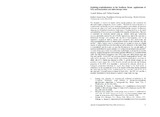
Antarctic Legacy Archive
Exploring trophodynamics in the Southern Ocean: applications of fatty acid biomarkers and stable isotope ratios
- ALSA Home
- →
- Documents
- →
- Research: Events, Presentations, Posters
- →
- View Item
JavaScript is disabled for your browser. Some features of this site may not work without it.
| dc.contributor.author | Richoux, N.B. | |
| dc.contributor.author | Froneman, P.W. | |
| dc.coverage.spatial | Southern Ocean | |
| dc.date.accessioned | 2021-03-10T09:25:40Z | |
| dc.date.available | 2021-03-10T09:25:40Z | |
| dc.date.created | 2007/10/09 | |
| dc.date.issued | 2007/10/09 | |
| dc.identifier.uri | http://hdl.handle.net/123456789/28541 | |
| dc.description.abstract | The dynamics of transfer of organic carbon among producers and consumers has interested trophic ecologists for several decades1. This field of research has proven to be particularly challenging for those investigating aquatic environments, as organisms of interest are often very small, remote and/or behaviourally complex. Furthermore, many species of plankton demonstrate a high degree of feeding plasticity, as the nature and availability of food can vary considerably both spatially and temporally. The diets of consumers are classically studied using gut contents and/or gut fluorescence analyses, approaches that are limited to freshly ingested prey, and in the latter case to herbivorous feeding2. Two methods that provide a time-integrated view of an organism's assimilated feeding history and incorporate both herbivorous and carnivorous pathways involve the determination of stable isotope ratios and fatty acid profiles3 4. Stable isotope ratios in animal tissues can be used as tracers to original sources of carbon at the base of a food chain as well as indicators of the trophic level of a population5, and fatty acids can provide information on the type and quality of resources assimilated by aquatic animals over ecologically meaningful time periods6,7. The aims of our current study are to determine trophodynamics among the numerically dominant zooplankton species and to assess regional differences in ecosystem fitness within the Subtropical Convergence zone (STC) using both stable isotope ratios and fatty acid profiles. As the STC can act as an effective biogeographical barrier8 food webs and the dynamics of energy transfer from primary producers to consumers on either side of this barrier are expected to differ. As global climate change has the potential to cause major shifts in the location, strength and physical and biological properties of the STC9 it is important to understand the potential effects on the biological communities inhabiting the region. Any changes in the food quality or availability for the dominant species or in the trophic relationships among producers and consumers may have serious implications for top consumers such as fish, birds and mammals. Successful characterization of food webs in the STC will provide an excellent framework for future studies in Southern Ocean trophic ecology. | en_ZA |
| dc.description.sponsorship | Sponsored by the the Department of Science and Innovation(DSI) through National Research Foundation (NRF) - South Africa | en_ZA |
| dc.description.statementofresponsibility | Antarctic Legacy of South Africa | en_ZA |
| dc.format | en_ZA | |
| dc.language | English | en_ZA |
| dc.publisher | South African National Antarctic Programme (SANAP) | en_ZA |
| dc.relation | SANAP Symposium 2007 | en_ZA |
| dc.relation.ispartof | ARESSA THEME III: Biodiversity: Responses to Earth System Variability (Oral Presentations) | en_ZA |
| dc.rights | Copyright | en_ZA |
| dc.rights | Copyright | en_ZA |
| dc.subject | Research | en_ZA |
| dc.subject | Science | en_ZA |
| dc.subject | Meetings | en_ZA |
| dc.subject | Symposium | en_ZA |
| dc.subject | SANAP Symposium 2007 | en_ZA |
| dc.subject | Southern Ocean | en_ZA |
| dc.subject | Living Systems | en_ZA |
| dc.subject | Research | en_ZA |
| dc.subject | Marine Science | en_ZA |
| dc.subject | Ocean Science | en_ZA |
| dc.subject | Plankton | en_ZA |
| dc.subject | Stable Isotopes | en_ZA |
| dc.subject | Fatty Acid Profiles | en_ZA |
| dc.subject | Trophic Levels | en_ZA |
| dc.title | Exploring trophodynamics in the Southern Ocean: applications of fatty acid biomarkers and stable isotope ratios | en_ZA |
| dc.type | Abstracts | en_ZA |
| dc.rights.holder | Antarctic Legacy of South Africa | en_ZA |
| dc.rights.holder | Richoux, N.B. | en_ZA |
| dc.rights.holder | Froneman, P.W. | en_ZA |
| iso19115.mdconstraints.uselimitation | This item and the content of this website are subject to copyright protection. Reproduction of the content, or any part of it, other than for research, academic or non-commercial use is prohibited without prior consent from the copyright holder. | en_ZA |
| iso19115.mddistributor.distributorcontact | South African National Antarctic Programme (SANAP) | en_ZA |
| iso19115.mdformat.name | en_ZA | |
| iso19115.mdidentification.deliverypoint | Antarctic Legacy of South Africa, Faculty of Science, Private Bag X1, Matieland. Stellenbosch. South Africa. | en_ZA |
| iso19115.mdidentification.electronicmailaddress | antarcticlegacy@sun.ac.za | en_ZA |
| iso19115.mdidentification.organizationname | Rhodes University | en_ZA |
Files in this item
This item appears in the following Collection(s)
-
Research: Events, Presentations, Posters [480]
Material directly related to official scientific and research events
